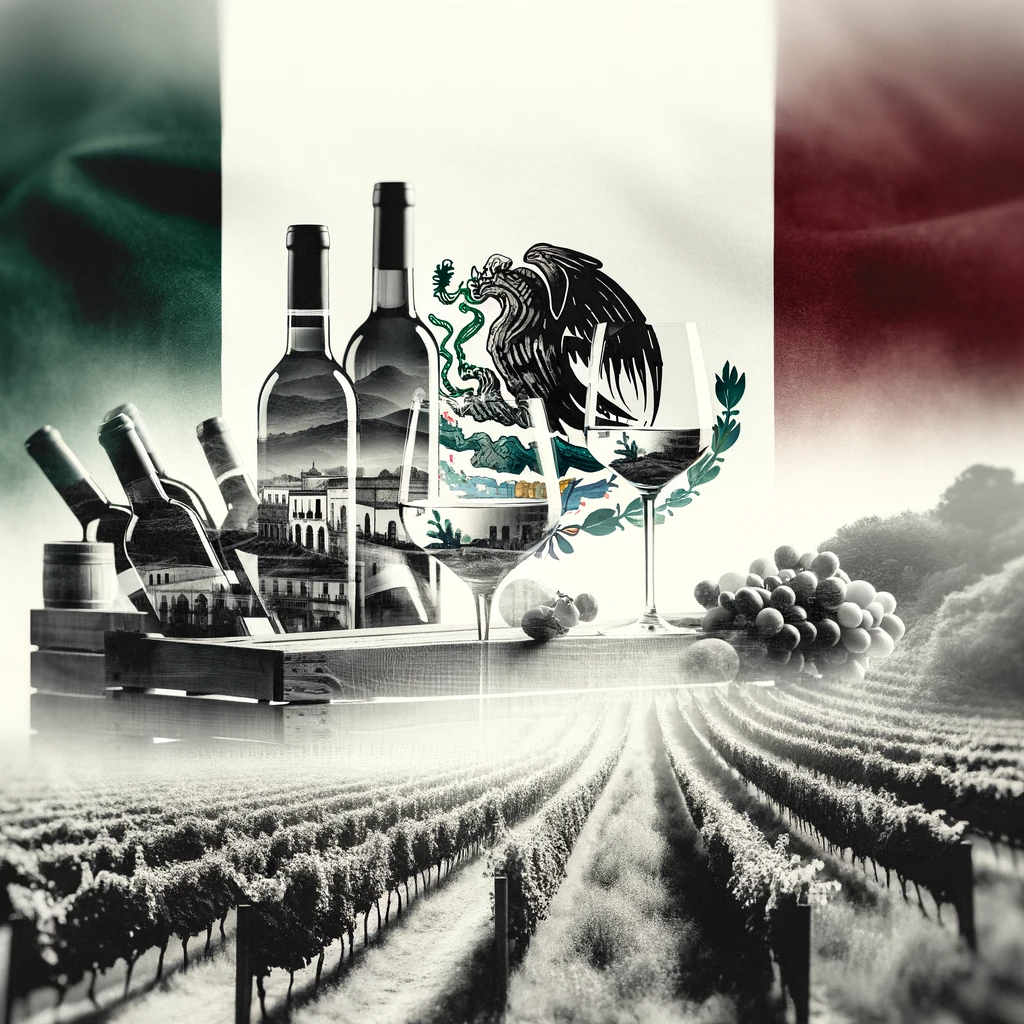Exploring the Vineyards of Mexico, Brazil, and Uruguay: A Journey into New Wine Horizons
As a sommelier, wine professional, or simply a wine enthusiast, we often find ourselves enamored with the renowned American wines — the robust Malbecs from Mendoza, the sophisticated Cabs of Napa Valley, the unique Carmenere from Chile, or even the exquisite ice wines of Canada. These names echo in our wine conversations and fill our glasses with familiar tastes. But what about the other wine-producing gems of the Americas?
In this blog, we embark on an exploratory journey to unveil the lesser-known yet equally enchanting wine regions of Mexico, Brazil, and Uruguay. Often overshadowed by their more famous neighbors in the wine world, these countries hold unique allure and are poised to surprise even the most seasoned wine aficionados.
We'll dive into their rich winemaking histories, discover their distinct wine regions and styles, and perhaps find a new favorite among their vineyards. Join me as we traverse these uncharted wine territories and broaden our oenological horizons.
Mexico: A Hidden Wine Treasure
Mexican winemaking began in the 1500s with the Spanish, making it the oldest in the Americas. At first, Spanish wines were more popular, but in 1699, a royal Spanish rule limited wine-making in Mexico, mainly for church use. This changed after Mexico became independent, leading to more wine production, especially in the late 1800s and early 1900s.
Despite challenges like the Mexican Revolution and plant diseases, the wine industry grew, especially in the 1930s and '40s. Today, Mexican wine is known worldwide for its quality. The country has many vineyards growing popular grapes like Cabernet Sauvignon and Chardonnay, showing a mix of tradition and modern, eco-friendly methods.
Mexico's Wine Regions
Mexico's wine regions are diverse and unique, each boasting distinct characteristics contributing to the country's rich wine heritage. The most renowned is the Valle de Guadalupe in Baja California Norte, celebrated for its full-bodied, ripe, and robust wines. This region is distinctive for its granite-rich alluvial soils and a notable "stoney minerality," a quality influenced by its proximity to the Pacific Ocean and the saline characteristics of its groundwater irrigation.
Other notable regions include Valle de Parras in Coahuila, which is known for producing high-quality wines in its favorable climate and soil conditions;
Querétaro, a region gaining fame for its sparkling wines and diverse grape cultivation, and Aguascalientes, with its unique microclimate and mountainous elevations, are ideal for quality wine production.
Here's the list of major wine regions in Mexico:
Valle de Guadalupe, Baja California Norte
Valle de Parras, Coahuila
Querétaro
Aguascalientes
Innovations & Varieties: The Evolution of Mexican Winemaking
Notable Grape Varieties in Mexico
In Mexico, a blend of international and native grape varieties flourishes, each adding its unique flair to the country's wine repertoire. Key among these are Tempranillo and Barbera, both red varieties thriving in Mexican conditions. Zinfandel brings its bold character, while Nebbiolo and Petite Syrah contribute to the rich diversity of the reds.
Not to be overlooked is the historical Mission Grape, a vestige of Spanish heritage, still making its mark in Mexican vineyards. Together, these grapes embody the adaptability and variety of Mexico's vinicultural landscape.
Modern Winemaking Innovations
The Mexican wine industry, rooted in history, is now driven by modernity and innovation. Freed from traditional appellations, Mexican winemakers embrace experimentation, leading to a rich diversity of wines and varietals. A renewed focus on terroir highlights the distinctive microclimates and land characteristics, while organic and biodynamic practices demonstrate a commitment to sustainable, environmentally friendly winemaking.
These contemporary approaches are shaping a new era for Mexican wines, characterized by quality and a true expression of their unique terroir.
Prominent Wine Producers in Mexico
L.A. Cetto
Vinícola Fraternidad
For more information about Mexican Wines, please click here.
Brazil: The Tropical Wine Frontier
The Brazilian wine industry's story begins with the Portuguese introducing vines in 1532, flourishing notably in the late 19th century in the Serra Gaúcha region, thanks to Italian immigrants. Throughout the 20th century, cooperatives, modern winemaking methods, and international investments significantly enhanced the quality of Brazilian wines.
Despite multinational companies' tumultuous entry and exit, Brazil's wine scene has recently been revitalized, driven by terroir research, technological advancements, and innovative techniques.
Today, as the third-largest wine producer in South America with over 300 wineries, Brazil is celebrated for its sparkling and fine wines, notably from the Valley of the Vineyards, its first Denomination of Origin. Continuously evolving, Brazilian winemaking holds a bright and promising future on the global stage.
Vale dos Vinhedos: Brazil's Sparkling Jewel
In the heart of Rio Grande do Sul lies Vale dos Vinhedos, a vital hub of Brazilian winemaking. This region is celebrated for its sparkling wines, crafted primarily from the local Muscatel grape. The cool climate and unique, chalky, sandy soils of Vale dos Vinhedos are perfect for producing these signature sparkling varieties. The region also cultivates popular grapes such as Chardonnay, Merlot, and Cabernet Sauvignon and is recognized for its innovative winemaking methods.
In Brazil, the heart of winemaking is Rio Grande do Sul, particularly around Bento Gonçalves and Garribaldi, which includes areas like Serra Gaúcha, Frontera, and the origin-controlled Vale dos Vinhedos. Cultivated since 1875 mainly by Italian and German immigrants, these regions showcase a rich winemaking heritage.
The southern border near Uruguay is known for its large wineries and modern techniques. Beyond these, Brazil's diverse wine regions, such as Minas Gerais, Paraná, and São Paulo, mainly cultivate Vitis labrusca grapes and hybrids suitable for the tropical climate. The unique conditions near the equator allow for two harvests annually but also pose challenges with heavy rains and the need for disease-resistant grape varieties and fungicides.
Brazil's Varied Wine Landscapes
Brazil's wine regions extend beyond Vale dos Vinhedos, each with distinct specialties. The Serra Gaucha region, deeply influenced by Italian immigrants, is known for its diverse grape cultivation. Meanwhile, the Caixa region in Minas Gerais stands out for its high-quality red wines, and the Planalto region in São Paulo is famed for its exquisite white wines, including Madeira styles.
These regions collectively contribute to the diverse and dynamic Brazilian wine scene, drawing wine lovers and tourists worldwide.
Renowned Wine Producers in Brazil
Vinícola Aurora
Pizzato Vinhas e Vinhos
Uruguay's Winemaking: A Blend of History, Innovation, and Terroir
A Rich Winemaking History
Uruguay's winemaking tradition dates back to the 18th century with the Spanish introduction of vines, flourishing significantly in the late 19th century due to the influence of European immigrants. These immigrants brought their grape varieties, rich wine heritage, and expertise. Today, Uruguay stands out in the global wine market as a small but distinguished player known for its commitment to sustainability and innovation in winemaking.
Prominent Wine Regions
The heart of Uruguay's wine production is the Canelones region, including Montevideo, contributing to 80% of the country's output. The region's clay and limestone-rich soils and moderate maritime climate are ideal for growing Tannat, Merlot, and Cabernet Sauvignon. Wines from these grapes are characterized by their dark fruit flavors, concentration, and firm tannins, showcasing the unique terroir of Uruguay.
Signature Grapes and Wines
Tannat, the flagship grape of Uruguay, symbolizes the country's wine renaissance. This early-ripening variety is integral to red and white wine production, creating distinctive and powerful wines. Alongside Tannat, other significant grapes such as Merlot, Cabernet Sauvignon, Chardonnay, and Albariño contribute to the diversity of Uruguay's wine portfolio. These wines blend Old World wines' nuanced, artisanal qualities with the boldness typical of New World wines, offering a range of styles that appeal to a wide spectrum of wine enthusiasts.
Uruguay's wine landscape, rich in history and innovation, presents a compelling story of a country that has skillfully integrated its European roots with modern winemaking practices, creating a unique and respected position in the world of wines.
Esteemed Wine Producers in Uruguay
Bodega Bouza
Viñedo de los Vientos
Conclusion
In conclusion, our journey through the wine regions of Mexico, Brazil, and Uruguay has revealed a tapestry rich in history, diversity, and innovation. From Mexico's ancient viticulture in the Valle de Guadalupe to Brazil's burgeoning wine scene in Vale dos Vinhedos and Uruguay's unique Tannat wines, each country offers a unique narrative in the world of winemaking.
Mexico's blend of traditional practices and modern techniques highlights its commitment to quality and diversity. Brazil, with its mix of Old World, influences and New World vigor, presents a rapidly evolving wine industry recognized for both its sparkling and fine wines. Uruguay, though small in production, stands out for its focus on sustainable practices and its signature robust Tannat wines.
These regions, each with their distinctive characteristics and contributions, invite wine enthusiasts and curious explorers alike to delve deeper into their stories. There's much to be discovered and savored in the wines of Mexico, Brazil, and Uruguay, and each bottle opened is not just a taste but a story of cultures, climates, and crafts. So, raise a glass to these exciting wine regions and embark on a journey of discovery and delight.






